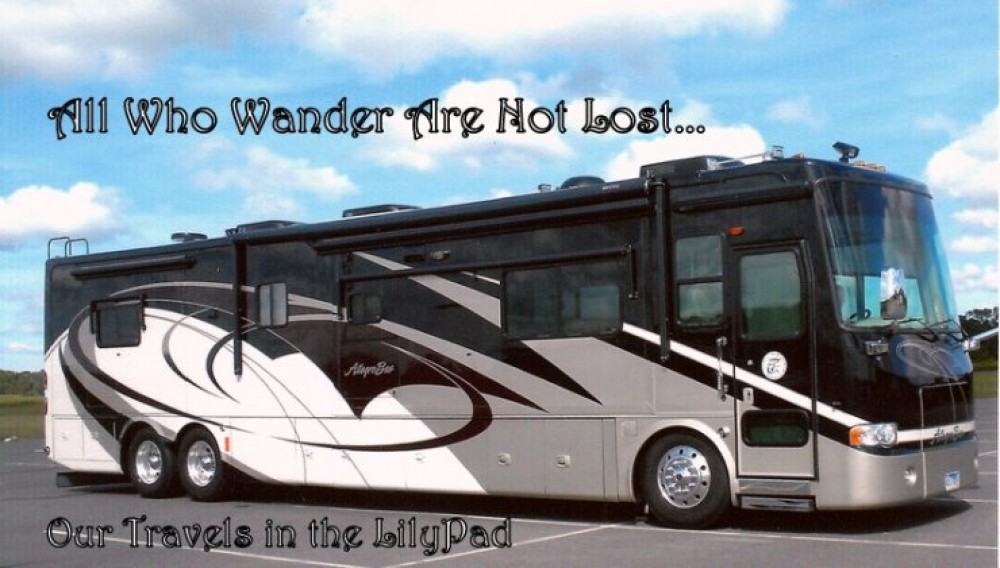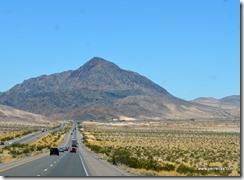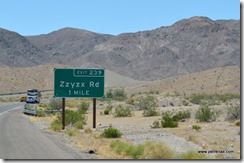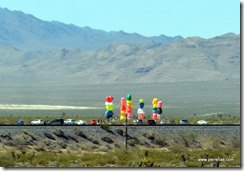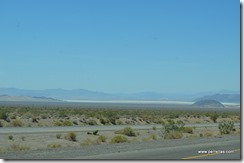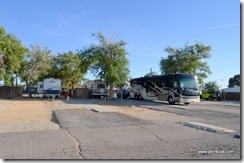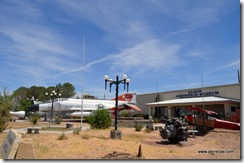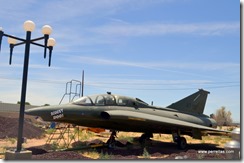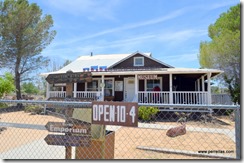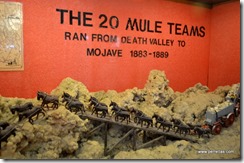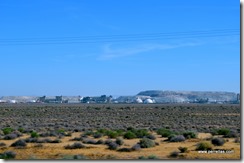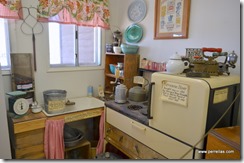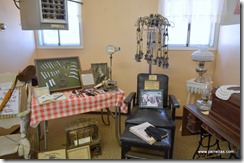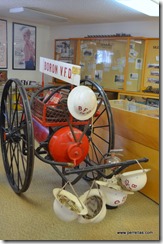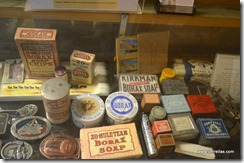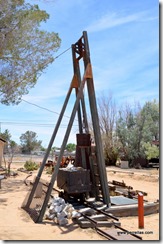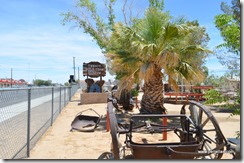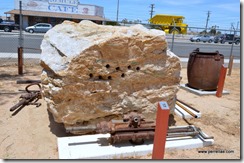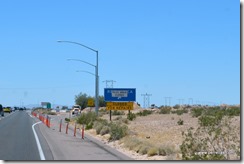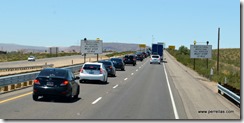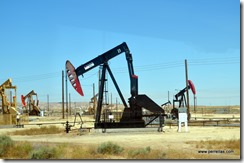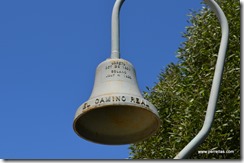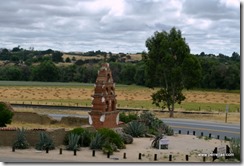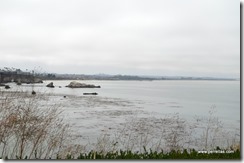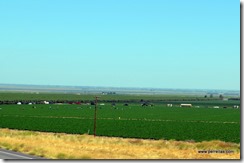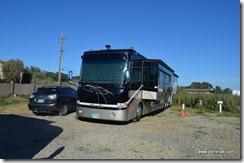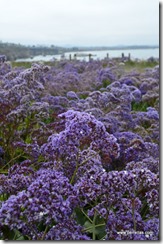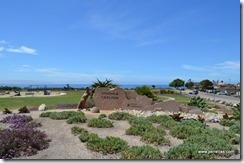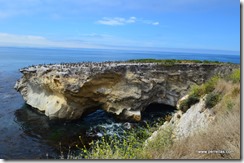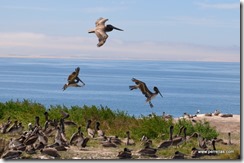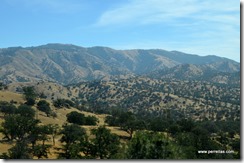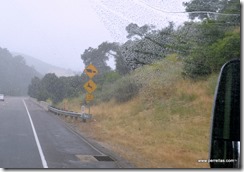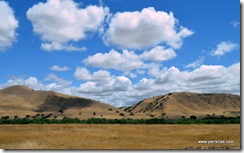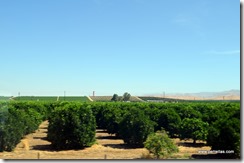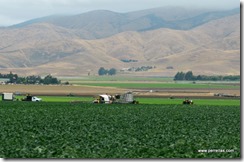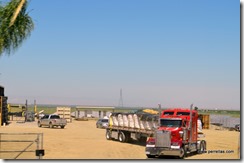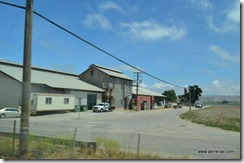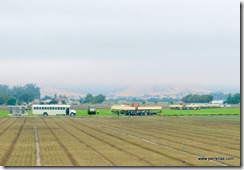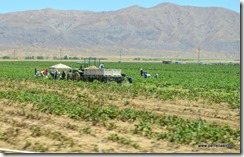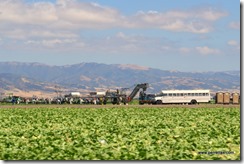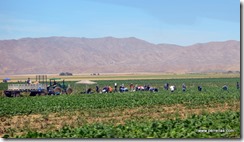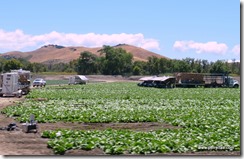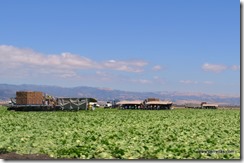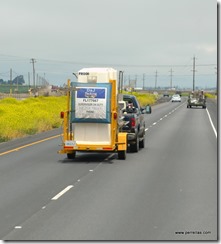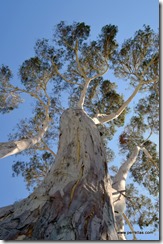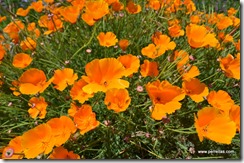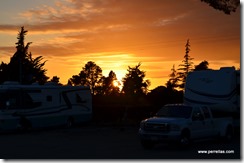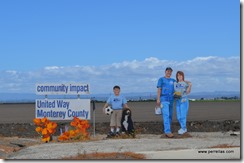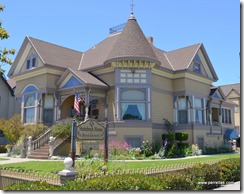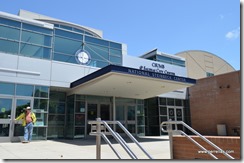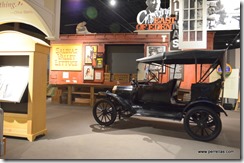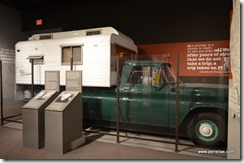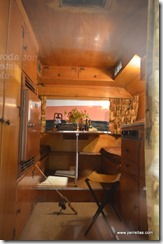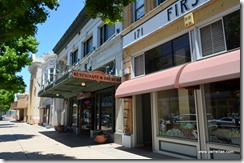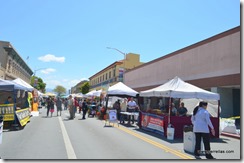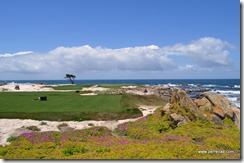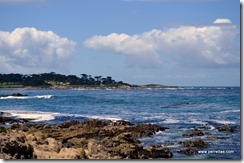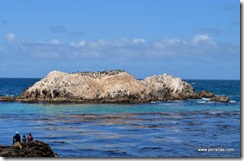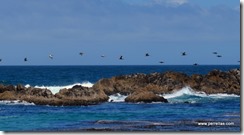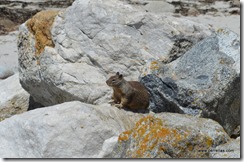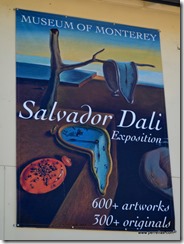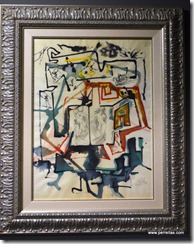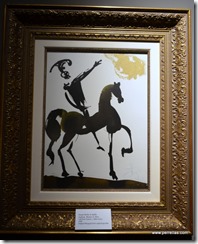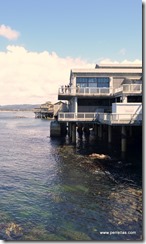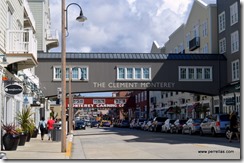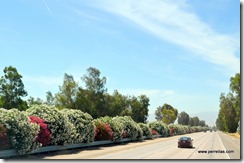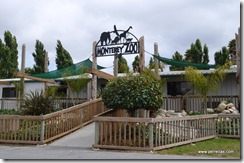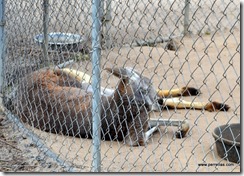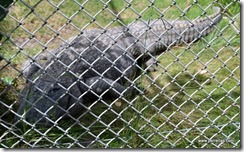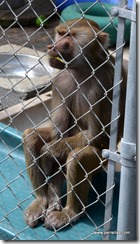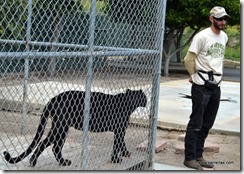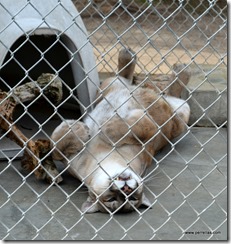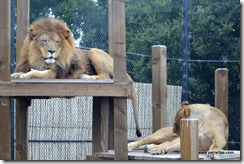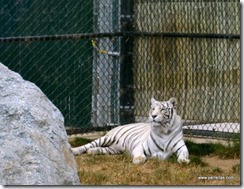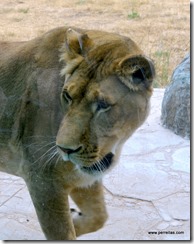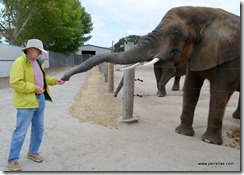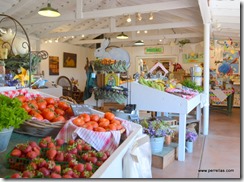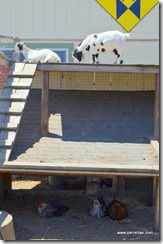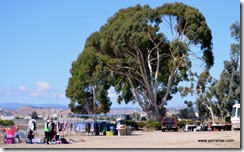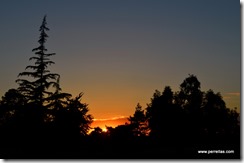Our journey to Boron California was a long tedious hot as hades haul from Las Vegas. Still in desert, Boron is a small sun bleached, wind worn town in the Mojave Desert.
The highest summit in the Mojave Desert is Cave Mountain, a refreshing change of scenery from the flat lands. After passing through, the picture returned to flat and barren.
Nearing the Nevada border line crossing, we passed Zzyzx Road leading to the fabricated town and oasis of the same name, formerly known as Soda Springs. What you would imagine an oasis to be, is what you will find. Palm trees surrounding water in the middle of a desert. Not willing to take our 65 feet off road or through small towns, I Googled the name. It has a history as strange as the name and worth the time spent reading. Traveling onward, our desert view, that of sameness.
Tall wooden poles stacked with brightly colored pillow shapes came into view with dozens of cars lined up nearby. No signs of their significance and never found out what they represented. Drop me a line if you know.
A late start from Texas resulted in our traveling through The Mojave Desert at the height of hellfire temperatures. Scrub brush being the only plant brave enough to rise to the surface and face the sun, the desolate view was consistent through to Boron.
A distant blip in the scenery was our overnight. Just off the highway, we rolled into the entrance of Arabian RV Oasis. Much appreciative of the 50 amp service, it was enough to run our two remaining a/c’s and help us survive the smoldering temperatures still surrounding us. The site was sparse but level with plenty of elbow room.
After setting up camp and having a good night’s sleep, we drove into Boron next morning to visit the Colonel Vernon P. Saxon Aerospace Museum and the Twenty Mule Team Museum. The Aerospace Museum was closed, actively being remodeled but there were a few museum quality examples of flying machines out front.
Directly next door to the Aerospace museum sits the Twenty Mule Team Museum.
Named for the borate mineral that was discovered in Kern County in 1913, the town of Boron grew up around the mining operations. The mule teams for which the Borax brand was named, operated from Death Valley to Mojave from 1883 through 1889. Business men gave the name “20 Mule Team Borax” from the number of mules it took to pull the wagon full of product through the desert.
Now owned by The Rio Tinto Boron Mine, the open pit borate mine is California’s largest and the largest borate mine in the world, producing almost half the world’s supply. On our way out of town, we passed the giant mine off in the distance. Neither of us had any interest in traveling over dirt roads to take a tour.
Borate is an interesting mineral. In chunk form, it can be polished to a beautiful opaque pearl hue and it will retain its perfection if kept in a dry climate. Such a delicate and pretty mineral, I wanted to take a piece home until the curator told me, in Houston’s humidity, it would decompose and turn into a fine baby power.
We entered the museum to a display of kitchen and family articles used by town founders. Some of these articles looked familiar, like those in my grandmother’s house when I was a child. And I’m aging myself once again.
The next room had a complete vintage fire fighting machine once used at the mine.
Lining the walls were displays, Borax products and articles from Boron’s pioneer beginnings. The museum curator chatted easily with John and I, no one else was in the building, telling us about the history of the town.
When I questioned if she had lived here all her life, she replied she was from Hinkley, a town 30 miles away and of course, it piqued my interest.
Now a ghost town, Hinkley’s claim to fame was the poisoning of the town water supply after Pacific Gas and Electric(PG & E) allowed groundwater contamination from a compressor station to leach Hexavalent chromium. The curator pointed to the albums of newspaper articles and photos from the movie, Erin Brockovich, and stated the crew and cast were guests of Boron while the movie, shot in 2000, was being filmed.
The movie, Erin Brockovich, was the true account of a legal clerk and environmentalist who worked for lawyer Edward Masry and began investigating the elevated cluster of illnesses in the community in 1993. She doggedly stalked and successfully brought PG&E to its knees. Because of her efforts, the plight of the people of Hinkley became widely known. In 1996, the families settled for $333 Million, the largest settlement every paid in a direct-action lawsuit in U.S. history.
When the film was released, Julia Roberts brought Erin’s story to light. While the movie was being filmed, the crew and cast took pictures together with locals and residents of Hinkley and Boron. The Boron museum has pictures of the filming from start to finish.
We thumbed through the photos and read some of the newspaper articles. Being involved in environmental issues all my adult life, I was fascinated hearing about the event from someone who watched, from a front row seat, the events unfold.
Browsing through the balance of the museum and stopping to continue my chat with the curator, John chose to sit patiently outside. Considering items in the gift shop, depositing our donation in the box, thanking the curator and finally exiting the museum, we took a quick peek outside in the yard.
A remarkably complete vintage mining car and wench sat near the side yard. Working conditions in the desert must have been unimaginably horrid for employees in the 1800’s.
We took a few steps, not finding shade from the blistering heat, snapped a few pictures of vintage boring tools and mining tools, got back in the car and turned the air conditioning on full blast.
Wicked hot outside, we drove around the small town area, the entire tour taking less than 10 minutes. Returning to LilyPad for cool down time, a Red Box movie, sleep.
Our RV site was the fly over zone for Edwards Air Force Base, home of the Air Force Test Center. Daytime silence occasionally interrupted by the swoosh of jet engines zooming overhead, so close they shook LilyPad. At night it was peaceful and quiet.
A 7:00 a.m. Willie’s wakeup song eased open our eyes and we were “On The Road Again” in under an hour. We will pause somewhere down the road, continuing on until we reach Oceano California and the Five City Elks Lodge.
Still in desert we traveled on, checking all road signs for open rest stops, zero found so far. There were none open back in 2013 or 2014 our last pass-throughs. Remodeling signs were still up at each but activity looked suspiciously idle.
California is persnickety about what they allow into their State, specifically no citrus this time through. My doctor nixed all citrus for me so none is on board. That was easy.
Passing oil pump jacks, we didn’t stop to count but there looked to be hundreds of them crowded together along miles of deserted barren land. Close together, the property becomes completely useless, total destruction of land. John, having worked in the Texas oil field business for 30 plus years, told me close quarter spacing is no longer allowed in Texas for that exact reason.
Along most of the freeway runs the old El Camino Real, Spanish for Royal Road and also known as the Kings Highway. 600 miles long connecting the 21 Spanish missions in California. Mission San Miguel was the first we passed. These commemorative bells roughly trace the original route. My Bucket List has visiting all the California and Texas Missions on it, somewhere near the middle. I’m considerably behind schedule.
The ocean boarders the freeway in stretches, receding then replaced by earth covered in the green of growing produce. The next few days we will travel alongside the countries thriving farm belt.
Early afternoon arrival, long back up into our wide gravel site, set up camp and relax. Tepid weather outside floated through our screen door. Slightly briny seaweed smells from the ocean, a short block from our site, was a welcome scent. My lungs celebrated the cool saline sea air. We wouldn’t need an air conditioner tonight.
Waking early to the sound of joyous songs and dancing feet on our roof, compliments of the local bird population. Reminiscent of mini tap dancers, they moved from one end of our motorhome to the other, striking the roof haphazardly with their nails, prancing and dancing, all the while in loud proclamation of it being morning. Natures noisy little tap dancing alarm clocks.
Today, grocery shopping first, beaches afterwards. In the afternoon we drove to Dinosaur Caves Park and enjoyed the cool but sun shiny walk along the cliffs. The walkways were accented by brilliant billowy purple blooms.
Easy flat walking paths, corralled by sea sturdy plants and flowers with an amazing view of the ocean in the background, all added to our pleasurable stroll.
Margo Dodd Park was a short ways from Dinosaur Caves Park and an excellent place to sit on wooden benches and watch the pelicans take off and land from their semi private roost. Gulls noisily fought for space on the overcrowded rock.
Beaches were pet friendly and KatieBug had many friendly greetings by several giant size fur babies, everyone sniffing all the pee-mail along the trails.
Each morning John walked with KatieBug to Pismo State Beach. Most mornings were shrouded in fog all along the coast but refreshing as long as your walking was brisk. Some mornings I slept in, enjoying the coolness from under warm blankets and a soft pillow.
One night we decided to participate in the Bingo games at the Lodge. Completely unaware of members extreme dedication, everyone seemed to be gung-ho about Bingo, we bought a dot marker, two game sheets and sat across from a die-hard Bingo player who nearly covered half a cafeteria table with sheets. Neither he nor we won but it did pass the time and when conversation was allowed, we found him to be an interesting table companion.
Walking back to our site for bedtime, the night was cooled by fog and light breezes had the scent of seaweed and the feel of warm summers by the ocean. Childhood seaside memories floated along with me while we walked.
One more day of coastal living before we would be on our way. The usual housekeeping and stocking up on supplies completed before noon, the afternoon was spent ocean-side, watching the waves and seagulls.
Evening was heavenly, breezy, cool with patches of fog, a decent sunset then back to our motorhome to sleep.
Morning arrived and we began the next leg of our journey by driving into the mountains, through dry hills, the came the rains and we spotted warnings of deer and black bear crossing,
across more flat dry land and past fruit orchards,
and finally rolling us out onto one of the most productive agricultural regions in the world.
Watching farm hands in the fields, passing way stations with harvests waiting to be loaded into trucks, trucks full and pulling out on their way to distributors. The odor, when we passed by, told us they were carrying onions.
Sometime this afternoon we would reach Salinas and stay four nights at the Salinas Elks Lodge. As a child, the many times our family passed through Salinas was en route to the ocean with the Pokey Penguins, my father’s skin diving buddies. Mostly farm land, old warehouses, farm houses and trailer parks, I never imagined it had any cultural appeal.
“The use of traveling is to regulate imagination by reality, and instead of thinking how things may be, to see them as they are.” Samuel Johnson, 1709 to 1784
Our visit to the farm lands of California brought into focus the impasse between the food consuming public and the farm owners who employ poverty level field workers. The rising operating costs, ever increasing water expenses and difficulties of using migrant workers makes farming sound unappealing and not near worth the effort and cost that must be expended.
Traveling by land forces you to see people. Crossing miles of California’s large agriculture industry exposes the abject poverty working and living conditions for full time and migrant workers.
Seeing the multitudes of field workers all across the farm belt confirms the importance they play in crop production, yet they are financially unappreciated.
As we drive, the land is banded together by endless rows of green, separated by thin brown lines of earth and dotted by humans and machines.
Gatherings of colorfully clothed farm hands and field workers were checking crops, picking, pulling, bent over tending the crops alongside gigantic John Deere Tractor type rolling machinery.
Dozens of small businesses catering to local farmers passed us, offering necessity services for migrant workers and field hands.
Nearing our destination, we saw the humongous eucalyptus tree before spotting the Elks Lodge hidden behind. I rolled down the window and breathed in deeply. The tree’s scent was intoxicating. John took the car off the dolly, I backed us into our spot, set down stabilizers and took KatieBug for a stroll alongside the neighboring golf course.
Our site was a gravel covered rectangle with 50 amp, water, local TV and access to a black tank dump. Across the street, the local airport planes flew sporadically and we were told, only during the day. The far end of the Elks Lodge parking lot was being set up for a weekend Flea Market. Near the golf course, a patch of brilliantly golden California Poppy’s swayed in the gentle breeze.
Night crept over the parking lot after showing off a colorful sunset peaking out between the treetops. Bed, sleep, quiet.
Concerned we would not have enough to occupy our time, I consulted TripAdvisor and our days immediately became overflowing with outings. The basin was the hometown of Nobel Prize in Literature laureate John Steinbeck. Several of his novels were based on the fertile basin area’s downtrodden. I was a fan of Steinbeck so a visit to the Center took first place on our list.
Being an avid reader, Steinbeck’s novels were a part of my reserve, introduced by my mother and enjoyed throughout my bookworm teen years and subsequent adulthood. Being a skin diver, my father knew several farmers in the valley whose property abutted the ocean. The divers were welcome and payment for diving privileges was fresh catch of the day, often times, in large quantities.
The farmers plight and those of their field hands and migrant workers were a part of my adolescence but mainly from a distance. Because entertainment for the field workers often included cock fights (roosters with blades on their feet encouraged to fight to the death), I could play with the children when they were on the beach but was never allowed near their barns.
Up early, we were on the road and looking forward to our first stop. Along the route many of the billboards and signs were cut-outs of people. Interesting and eye catching.
Our first day long outing was the Steinbeck House Gift Shop and National Steinbeck Center. The gift shop occupied the basement of Steinbeck’s birthplace and childhood home, a Queen Ann style Victorian, built in 1897.
Stately and beautifully renovated, a lunch restaurant occupies the living quarters of the house. After browsing through the gifts, we drove the short distance to the National Steinbeck Center near the main thoroughfare of downtown Salinas.
Welcomed by friendly staff, we walked slowly through the museum skimming through the wordy exhibits. Most impressionable was the struggle of farmers and field workers in the valley during the 1930 and 40’s, of much concern to Steinbeck, his writing bringing light to the difficult way of life. One quote from the Center read: “It’s one of the ironies of farming. Ultimately farmers are financially penalized because of their ability to produce”.
“Travel is fatal to prejudice, bigotry and narrow-mindedness” Mark Twain
Housing options remain dismal for farm workers. We passed many single wide trailer park housing compounds where the units were within inches of each other, no room for cars, no front or back yards. Knowing California rental prices are continually skyrocketing, I had read most all migrant workers live in trailer camps, three and four families living together, with rents as high as $600.00 a trailer. Paying for basic living expenses and bus transportation to the fields is said to have pushed combined incomes for these families below poverty level.
The museum is expansive for readers but still of interest for those seeking an overview in pictures, video’s and props. My favorite exhibit was the truck camper from Travels With Charley: In Search of America.
Not spacious inside but room enough.
Steinbeck wrote a travelogue while on his extended road trip with his poodle in 1960. Naming his specially designed camper Rocinante, after Don Quixote’s horse, he traveled nearly 10,000 miles, following roads that touched as many states as possible while following a reasonably direct route around the outer of our United States. He claimed the purpose was to see the country of which he wrote and visit personally the America on which he based his novels. The result was him having concerns for the “new America” he was witnessing.
In later notations made by the author’s eldest son Thom, the real reason for his father’s journey was to see his country one last time. John Steinbeck knew he was dying from a heart condition.
Another of Steinbeck’s novels, The Winter of Our Discontent, is based on a family in an imaginary town in New England, directly based on the town of Sag Harbor. The father, born to wealth but fallen on hard times, is unhappy that his spendthrift wife is never satisfied and his children want everything. Set in 1960, it might have been his reason for traveling around America in what Generation Y, The Millennial’s, call a “tiny house”. Steinbeck wrote, “Having too many THINGS, they spend their hours and money on the couch searching for a soul.”
In 1966 Steinbeck wrote: “We shout that we are a nation of laws, not men – and then proceed to break every law we can if we can get away with it. We proudly base our political positions on the issues – and we will vote against a man because of his religion, his name, or the shape of his nose.”
His statement didn’t take much research to pull up the political campaign to which “the shape of his nose” remark referred. Nixon and his prominent nose clearly won the radio campaign, however, Kennedy won the personal appearance and television campaign.
With his finger on the pulse of America’s turbulence in the 50’s and 60’s, his commentaries were bluntly eloquent . About school integration in New Orleans in 1960 he wrote: “It would be difficult to explain to a dog the good and moral purpose of a thousand humans gathered to curse one tiny human.”
In 1933 to 1940, approximately 3,500 Dust Bowl migrants settled east of Salinas. Two local farmers subdivided their property and offered plots for sale but many of the “Okies” were cash poor, instead accepting work in the lettuce and vegetable industry. The work helped protect Salinas from the worst of the Depression years. With unemployment rising, one response was to expeditiously deport large numbers of Mexican workers, seen as competing with U.S. Citizens for jobs. It seems the more things change, the more they stay the same.
Walking back to the car, we passed through the downtown area and perused the produce being offered at the Salinas Farmers Market.
Learning about a barn out standing in a Salinas field called The Farm, I was still searching for fresh apricots and figs so we added the stop to our itinerary.
Our next extended day long trip was to Monterey while KatieBug was treated to a day of pampering, enjoying a full spa with mani-pedi experience at PetSmart.
It had been years since we traveled along Monterey’s 17 Mile Drive, a pay-for-view experience winding past California’s wealthy homes overlooking the ocean and bordering the famous Pebble Beach Golf Course.
These are premier spots for climbing among the rocks and poking into cracks and crevices to spot the stranded-in-low-tide sea life.
Stopping several times for the view, Bird Rock seemed to be the pause of choice for tour buses and tourists.
Out to stretch our legs, we took deep breaths of the refreshing salty sea air and watched continuous strands of feathered friends land and take off from what the locals had named “The Rock”.
Making the spa-like area between The Rock and shore their rest stop, we saw gulls, Cormorants, roosting pelicans and sea lions. The sea otters were difficult to spot without binoculars.
Signs saying “do not feed wildlife” apparently were ignored. Rocks near the water were well populated with chunky, noisy, aggressive squirrels.
The drive, taking close to an hour, emptied us onto the freeway and near Monterey’s newer wharf area. I had read that Monterey opened a privately owned Salvador Dali Museum in Monterey. We parked and walked part of the wharf before spotting the huge dripping clocks advertisement sign for the Museum.
John being a fan, we paid the overpriced entry and viewed the Adult graphic sketches and signed prints. There were few prints without lewd images but I found two acceptable if you don’t look to close.
After viewing, I mentioned to the young man at the desk, my expectations were of seeing at least an oil painting, considering the advertisement showed one of his paintings, not his prints. His snippy remark was “Dali was a printer, what did you expect to find?” Very unprofessional, very rude, very college age I-know-everything attitude. I showed my appreciation for his inappropriate response by leaving a blunt comment on TripAdvisor.
Although interesting, the signed prints were primarily of extreme adult content with a miniscule amount of first run prints. What we enjoyed most were the short films shown in the screening room of the museum. Also extreme in adult content, the films followed his life and relationships as narrated by an acquaintance. It was intensely apparent Dali struggled with sexuality and reality. The films gave insight into his demons, his odd marriage relationship, his greedy wife, his obsessive and destructive lifestyle and lingering death.
Leaving the museum area, next visiting the waterfront streets of the abandoned sardine canning factories.
In 1941 through 1945, the sardine canneries were where many immigrants found work. Conditions were wet, cold and smelly with the roar of machines and clanking of cans drowning out a multi-cultural chorus of languages in Chinese, Spanish, Portuguese, Sicilian, Japanese, Mexican and English. Within five years, the industry had died after decimating the supply of sardines.
Revived as shopping, dining and wine tasting, anchored by the Monterey Bay Aquarium, the upscale shops and dining establishments still make for an enjoyable stroll through the area.
The last factory closed in 1973 and my earliest memories of the factories are sealed by photo reminders from dad’s old skin diving photo albums. While the Pokey Penguins went ocean spear fishing, I wandered under the boardwalk during low tide. The towering black wooden piers securely attached to a cave-filled rocky coastline, outcroppings of giant boulders, dank and cool underneath the factories, premium for investigating sea creatures clinging to the wood and rocks. Never tiring of the experience, it occupied hours of my time.
On the way back to LilyPad, I notice the freeways continue to be lined with blossoming Oleander, the most popular ornamental plants in the arid region, also one of the five most poisonous.
Next morning we reviewed TripAdvisor to double check locations and decided on a doubleheader. First stop, the Monterey Zoological Society Wild Things Program. Located on the 51 acres of Vision Quest Ranch, the zoo and facility is the vision of Charlie Sammut .
Beginning as a home for working film and TV animals, Charlie with his lion Josef at his side, worked to improve comfort and living standards in a safe environment for the industry’s animal stars.
In 2008, at the age of 22, Charlie’s special partner Josef the lion, passed over the rainbow bridge. Charlie continued his work, providing trained animals a better quality of life not dependent on a given industry.
In recent years, California’s high cost of production and filming drove business out of state leaving the facility searching for a new purpose. With the help of volunteer workers and donations from generous companies, the Ranch evolved from a home for working movie and TV animals to a Safari Bed and Breakfast, Special Event Site, private/custom educational programs and zoo tours open to the public. Now home to working and retired TV, circus and undomesticated animals donated by person’s previously keeping them as pets, the zoo houses a wide selection of wild things.
An elderly retired kangaroo.
Several pet alligators.
A retired baboon.
Our tour guide next to the black panther enclosure.
Another former pet, released to the sanctuary. There are dozens of rescued wild things at the Ranch.
A funding source, known to Charlie but referred to only as, the “donation angel”, brought new life to the Ranch, eventually opening several showcase homes for lions and tigers and bears, Oh My!
I learned about White Bengal Tigers from sanctuaries we visited in the past. They are not endangered because they are not able to pass on the missing pigment naturally, without human imposed interbreeding. When the color gene is found missing, humans breed father to daughter, sister to brother, etc., destroying any tigers born of normal color. So sad that people are led to believe the missing gene is a natural process but it is no more natural than crossed eyes, it is a defect. The incesstual breeding forced upon tigers often result in severe deformities.
The new super-size enclosures have giant clear display windows on the ground level allowing a close up encounter for the cats and humans. The lion is watching a little boy from our group rush past the window. I didn’t see her licking her chops but the pray instinct was very apparent by the lions reaction.
Continuing to capitalizing on Monterey’s tourism industry, the Ranch continues to expand and has become an exceptional educational experience for the public. Now called “Monterey Zoological Society”, the tour has knowledgeable, well trained and interesting guides, close up views of the animals and is definitely worth the price of admission.
Paying a slight upcharge so we could feed the elephants, it was a fun experience. The highlight was watching one participating family’s young preschool boy stretch out his arm to give a carrot to the gigantic bull elephant. Not terrified but certainly hesitant with only a thin wire between them, his father took over after his son became frozen and motionless.
After visiting the Zoo, we rode out to The Farm.
Offering organic fruits-of-their-labors for sale, we found fresh flowers, produce, eggs, baked goods and gifts along with a clean, well-kept petting zoo.
Still searching for ripe apricots and fresh figs, none were available at The Farm but we came away with ruby red sweet cherries and a photo of farm animals from the petting zoo experience.
Returning home to the Elks Lodge, the flea market was up and running so we strolled through in search of a good deal. If something was found, something else must go, so I considered my purchase carefully. A terracotta pot for a future planting of California succulents was an item on my “want” list. We found a space in the car and I traded a basket for the pot. I hope to find unusual plants along the coast to bring home to Texas.
Tonight the Elks Lodge was having a Karaoke night. Known for their extremely reasonable drink prices, we walked down to enjoy a nightcap, music and the possibility of entertaining songsters. For the first two people, we needed more to drink. The third person drank too much himself, his performance loud and boisterous, causing John to quash an explosive laugh-out-loud. Either we were suffering from a serious liquor buzz or the balance of the singers were enjoyable. After our third round, the sun was setting and it was time for sleep. I snapped a photo of the waning sunset after reaching LilyPad, walked KatieBug and we all turned in for the night.
In the morning we will pack up and drive the short distance to Santa Clara, visit family and explore Silicone Valley Techie experiences.
